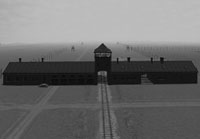By Young Sun Han
Advancements in technology allow artists to use new mediums for the creation of their artwork, and an ever-growing number of artists attempt to reconcile their practice with scientific expansion. However, artists are also among the first to dabble in the development of cutting-edge technology and bring it into wider use. Techniques during the initial advent of holography were greatly enhanced by artistic contributions in the 1960s and 70s. Applied Interactives is an artist-based non-profit that has such a mission: to bring wider attention to the applications of virtual reality technology in both practical and creative ways.
Special Treatment was an ambitious project they debuted in partnership with (art)n Gallery, located at 847 W. Jackson. Dubbed a portable virtual reality installation, participants were invited to explore issues of persistence and memory by interacting in a fully rendered version of Auschwitz II/Birkenau, Poland. A large projection screen, 3D glasses and headphones immersed the audience both visually and aurally. Interaction occurred primarily by use of a joystick-like controller that allowed movement through the space (similar to first-person-perspective video games). Beginning in the present space of the gallery, viewers were symbolically transported via train sequence to identification processing fields of the concentration camp. As the area was uncovered, phantom-like characters were encountered, sharing narrative bits of their experiences. Interiors of bunkers and guard towers could be explored while high gates loomed in the landscape. The initial allusion to role-playing and video games fell away because of the absence of mindless violence that permeates such games. Instead we entered a contemplative void.
Our collective memory of the Holocaust is often riddled with images of death, propagandistic symbols, and complete obliviousness to other historical events that share tragic similarities. Do media depictions simply translate and broadcast visceral experiences into digestible and emotional information for a wide public? The idea of wandering in a ghost town concentration camp is a strange one, especially when the environment is abstracted into sharp lines and vectors. Although the virtual experience can stand in for authentic representations, the connection between the viewer and the installation was not as fully realized or immersive as in a movie theater. Non-participants snacking on hors d’oeuvres served during opening night distracted further from the spatial fluidity.
Acceptance of virtual technology suffers from the misguided eye-candy that Hollywood presents as a future possibility. Still, Special Treatment is a sophisticated merging of movement, perspective, and sound. Its complex functions will further excite the pursuit of art techies working in such an emerging and fertile field. Perhaps the exhibition does not quite delve into the phenomenon of memory, but the installation comments on a longing to recreate what is lost and technology’s ability to substitute aura with artifice.
Image courtesy of Applied Interactives @ (art)n Gallery
February 2005








